Ultracentrifugation Study guides, Class notes & Summaries
Looking for the best study guides, study notes and summaries about Ultracentrifugation? On this page you'll find 40 study documents about Ultracentrifugation.
Page 3 out of 40 results
Sort by
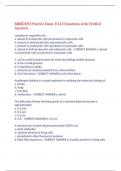
-
MMSC490 Practice Exam 1|123 Questions with Verified Answers,100% CORRECT
- Exam (elaborations) • 25 pages • 2024
-
- $11.79
- + learn more
MMSC490 Practice Exam 1|123 Questions with Verified Answers cytoplasmic organelles are: a. absent in prokaryotic cells and present in eukaryotic cells. b. present in both prokaryotic and eukaryotic cells. c. present in prokaryotic cells and absent in eukaryotic cells. d. absent in both prokaryotic and eukaryotic cells. - CORRECT ANSWER a. absent in prokaryotic cells and present in eukaryotic cells E. coli is a useful model system for molecular biology studies because: a. it has a smal...
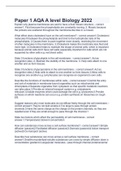
-
AQA A level Biology 2022/2023 AQA with verified questions and answers
- Exam (elaborations) • 13 pages • 2023
-
Available in package deal
-
- $12.99
- + learn more
Explain why plasma membranes are said to have a fluid mosaic structure. 1. Fluid because the phospholipids are constantly moving. 2. Mosaic because the proteins are scattered throughout the membrane-like tiles in a mosaic. What effect does cholesterol have on the cell membrane? 1.Cholesterol molecules fit between the phospholipids and bind to the hydrophobic tails of the phospholipids. 2.Causes them to pack together more closely, restricting the movement of other molecules in the membra...
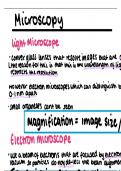
-
AS Biology-Microscopy/centrifugation and cell biology-summary
- Summary • 1 pages • 2024
-
- $6.16
- + learn more
This summary is hand written on aniPad contains in detail on the different types of microscopes , the process of ultracentrifugation and cell fractionation, features of eukaryotic cells/chloroplasts/prokaryotic/mitochondria.
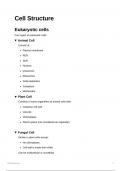
-
Cell Structure
- Summary • 9 pages • 2023
-
Available in package deal
-
- $7.10
- + learn more
Contains details of the different parts and organelles of a cell and their related functions. Different types of cells are listed with a list of organelles they typically contain. Eukaryotic and prokaryotic cells are both featured as well as the structure of Viral particles. Details of microscopy and cell analysis are listed and the process of ultracentrifugation is included.
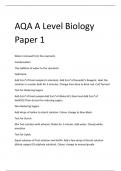
-
AQA A Level Biology Paper 1
- Exam (elaborations) • 25 pages • 2024
- Available in package deal
-
- $13.99
- + learn more
AQA A Level Biology Paper 1 Water removed from the reactants Condensation The addition of water to the reactants Hydrolysis Add 2cm³ of food sample (in solution). Add 2cm³ of benedict's Reagent. Heat the solution in a water bath for 3 minutes. Change from blue to brick red. CuO formed Test for Reducing Sugars Add 2cm³ of food sample.Add 2cm³ of dilute HCL then heat.Add 2cm³ of NaHCO3.Then do test for reducing sugars. Non-Reducing Sugars Add drops of iodine to starch solution...
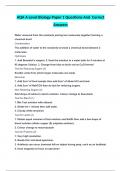
-
AQA A Level Biology Paper 1 Questions And Correct Answers
- Exam (elaborations) • 31 pages • 2024
-
Available in package deal
-
- $6.99
- + learn more
AQA A Level Biology Paper 1 Questions And Correct Answers Water removed from the reactants joining two molecules together forming a chemical bond Condensation The addition of water to the reactants to break a chemical bond between 2 molecules Hydrolysis 1. Add Benedict's reagent. 2. Heat the solution in a water bath for 5 minutes at 95 degrees Celsius. 3. Change from blue to brick red as CuO formed Test for Reducing Sugars (3) Smaller units from which larger molecules are made Monome...
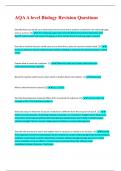
-
AQA A level Biology Revision Questions
- Exam (elaborations) • 82 pages • 2024
-
Available in package deal
-
- $22.63
- + learn more
Describe how you would use a biochemical test to show that a solution contained a non-reducing sugar, such as sucrose. [3] - ,first reducing sugars test; boil with dilute HCl acid then Neutralise with NaHCǑ, add benedict and heat to 95 degrees C brick red ppt forms if reducing sugar is present Describe a chemical test you could carry out to show that a piece of coconut contains lipids. [3] - (Crush in) ethanol / alcohol; Add (to) water (Order of adding is critical for this point); Emulsion...
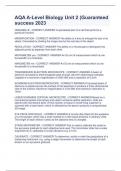
-
AQA A-Level Biology Unit 2 (Guaranteed success 2023
- Exam (elaborations) • 13 pages • 2023
-
Available in package deal
-
- $9.99
- + learn more
AQA A-Level Biology Unit 2 (Guaranteed success 2023 ORGANELLE - CORRECT ANSWER-A specialised part of a cell that performs a particular function. MAGNIFICATION - CORRECT ANSWER-The ability of a lens to enlarge the size of an object. Calculated by dividing the image size by the real size of the object. RESOLUTION - CORRECT ANSWER-The ability of a microscope to distinguish two adjacent points as separate from each other. MICROMETER μm - CORRECT ANSWER-An SI unit of measurement which is...
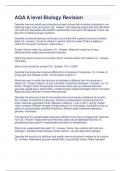
-
AQA A level Biology Revision
- Exam (elaborations) • 15 pages • 2023
-
- $12.99
- + learn more
AQA A level Biology Revision . [2] - Answer- Active site / enzyme not complementary; Active site changes (shape) / is flexible; (Change in enzyme allows) substrate to fit / E-S complex to form; Describe one way that the lock and key model is different from the induced fit model. [1] - Answer- Active site does not change (shape) / is fixed (shape) / is rigid / does not wrap around substrate / (already) fits the substrate / is complementary (before binding); Explain why the rate of reacti...
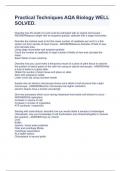
-
AQA Biology WELL SOLVED. Practical Techniques
- Exam (elaborations) • 2 pages • 2023
-
- $10.99
- + learn more
AQA Biology WELL SOLVED. Practical TechniquesDescribe how the length of a cell could be estimated with an optical microscope - ANSWERMeasure length with an eyepiece graticle; calibrate with a stage micrometer Describe the method used to find the mean number of capillaries per mm2 in a thin section cut from sample of heart muscle - ANSWERMeasure diameter of field of view and calculate area; Using stage micrometer and eyepiece graticle; Count the number of capillaries in large number of field...

That summary you just bought made someone very happy. Also get paid weekly? Sell your study resources on Stuvia! Discover all about earning on Stuvia


